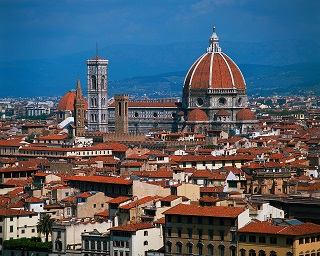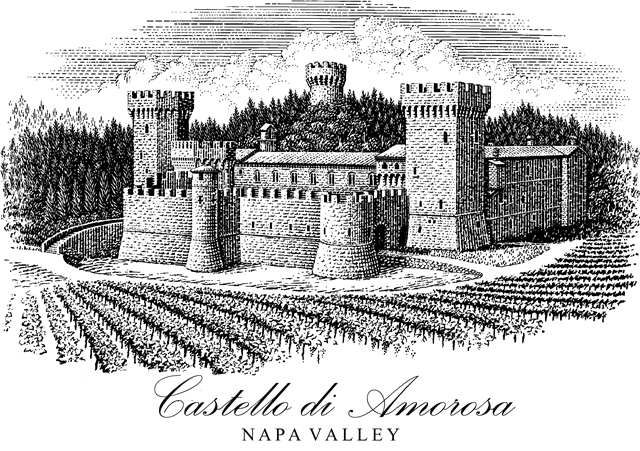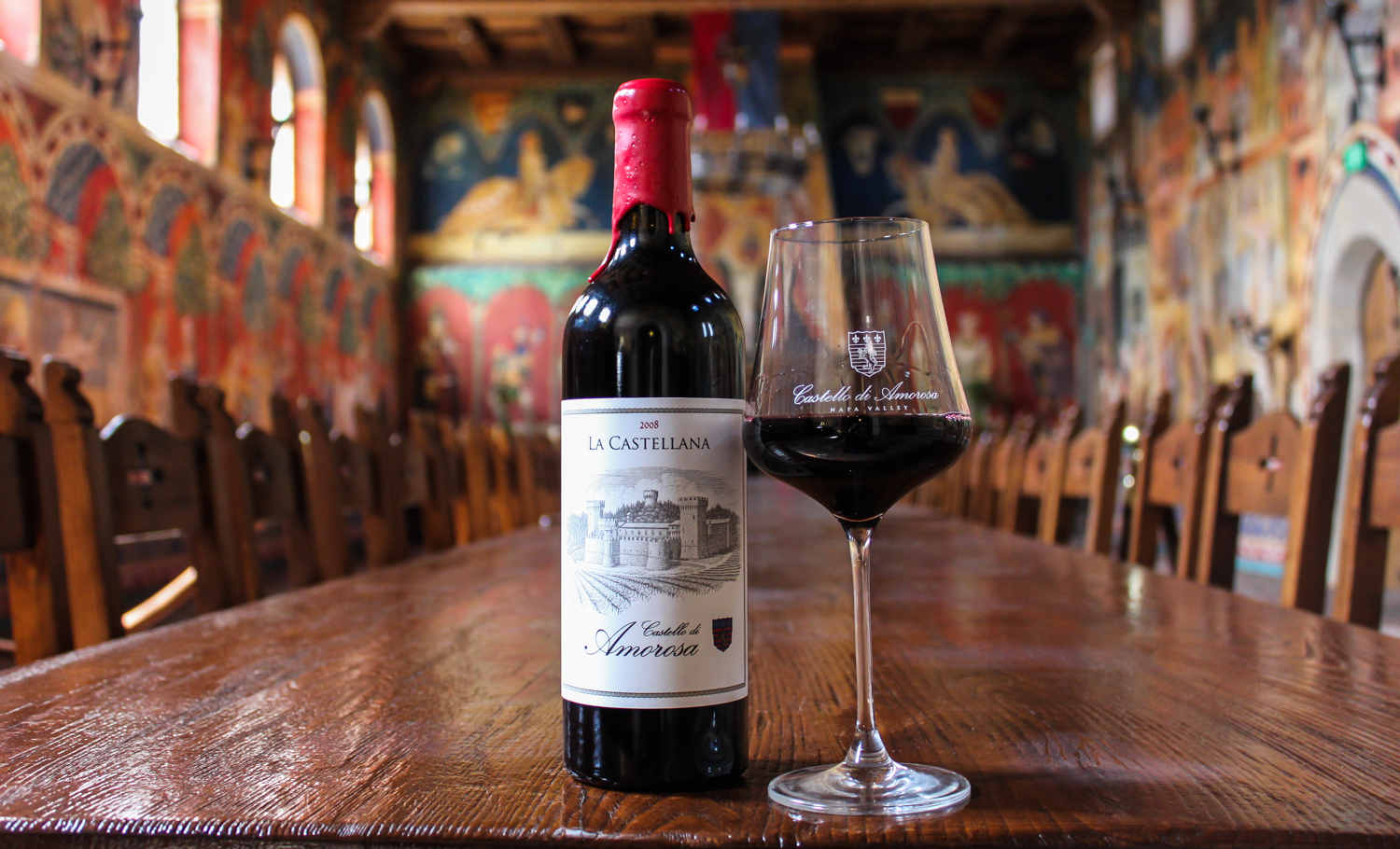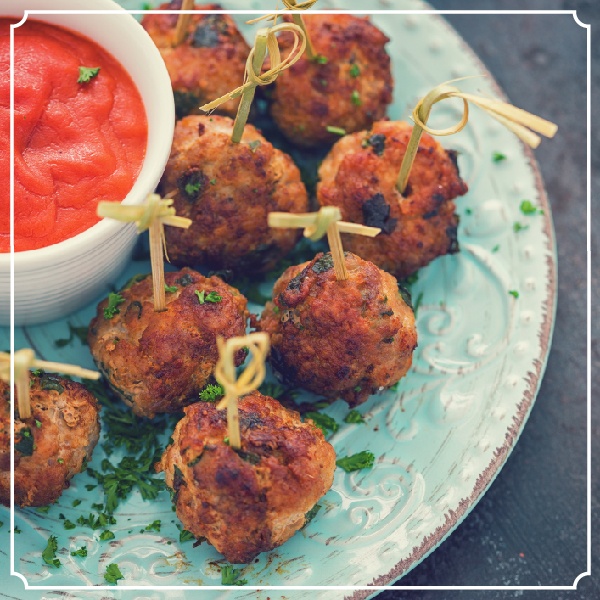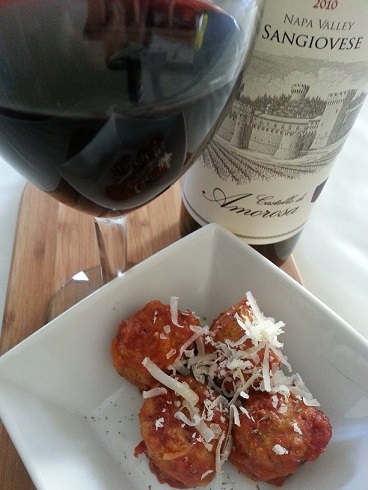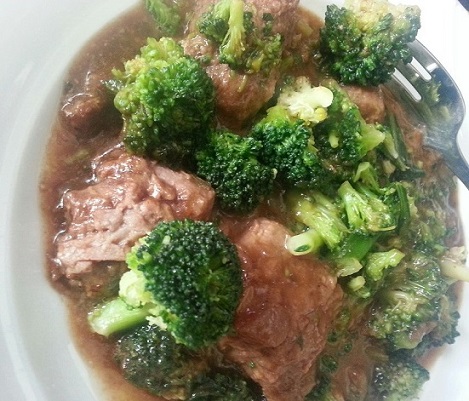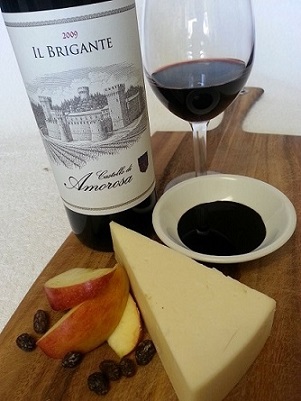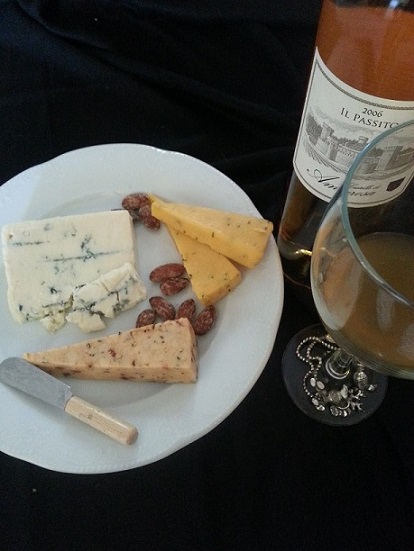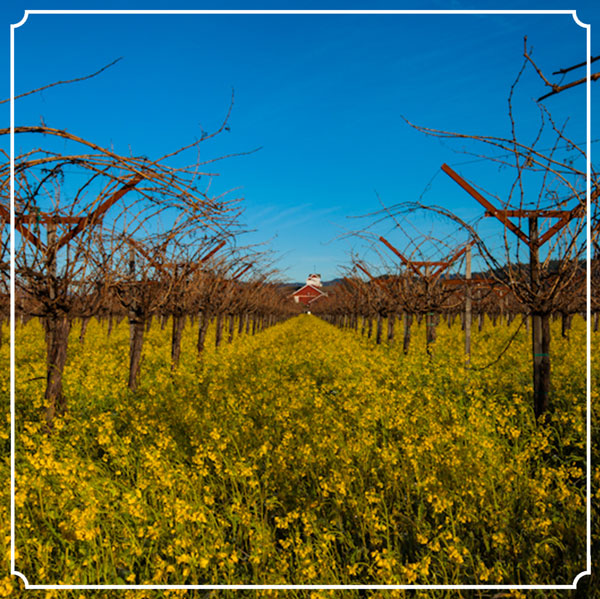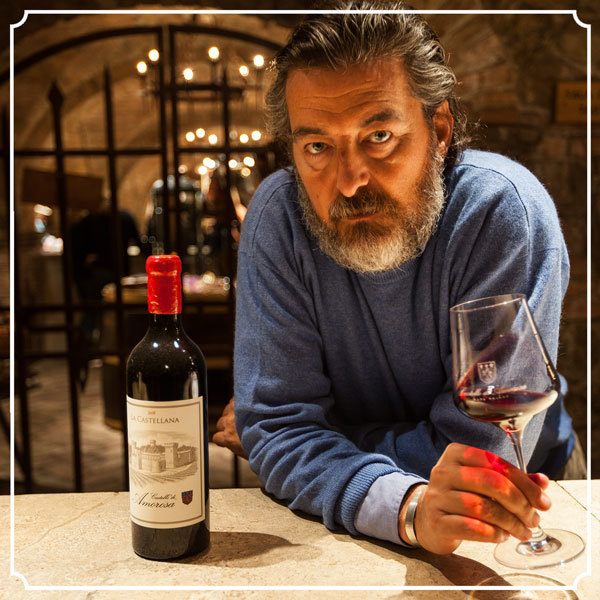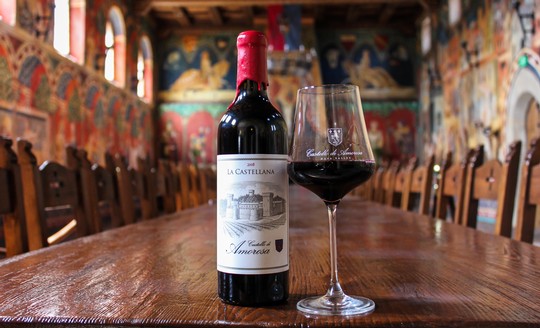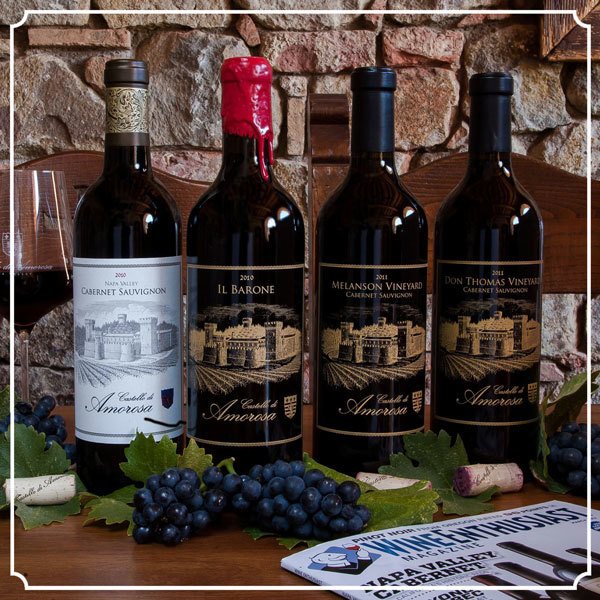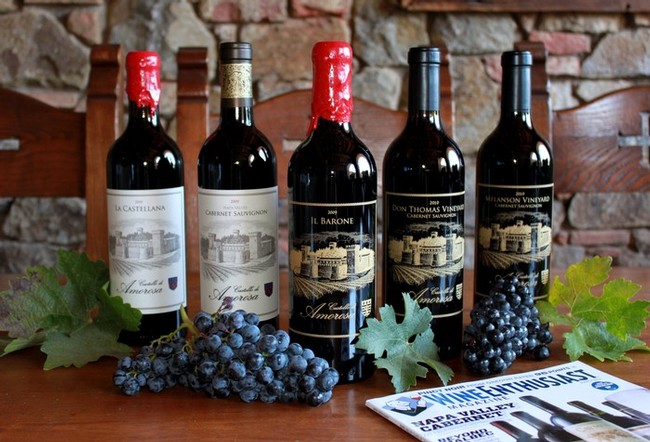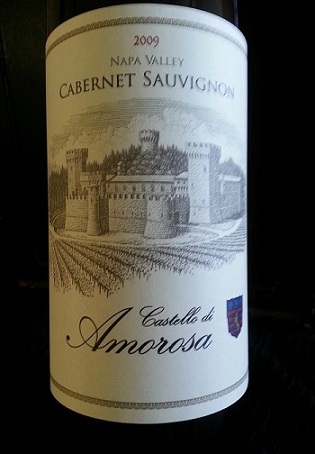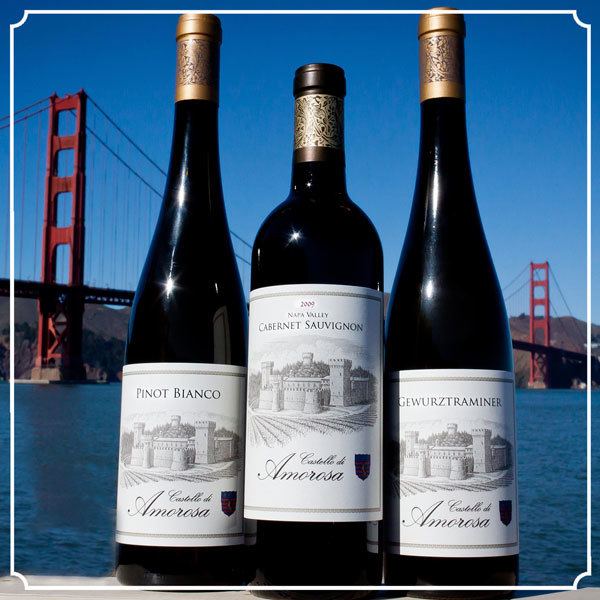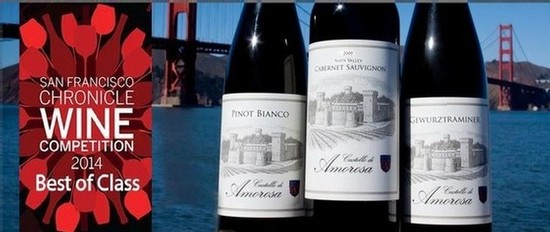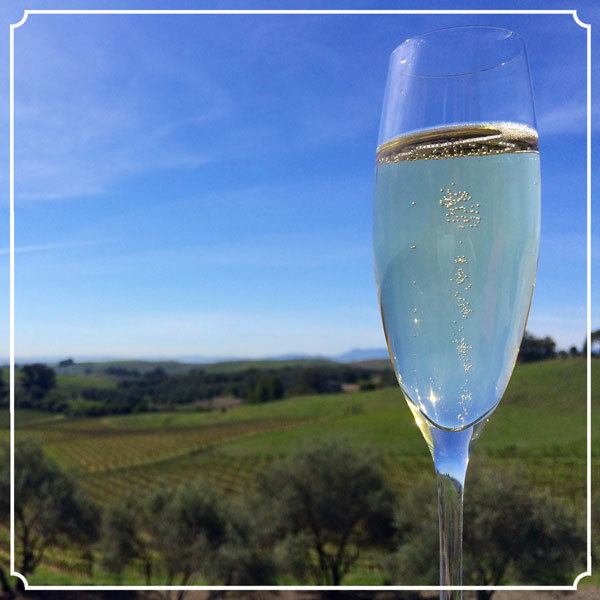The Perfect Blend

Mary Davidek
The Perfect Wine Blend: Blending Grapes & Varietals
We are getting ready for a wedding in our family, my step-daughter is getting married in September. Last week my husband and I had a pre-nuptial trip to Boise, Idaho for talks of wedding plans. This was all to be considered and discussed at a dinner which included my husband’s first wife along with the future parents-in- law, yikes! Decisions had to be made on apparel, cakes, invitations, shoes, music, relatives and ever-growing extended families. The evening was an interesting and diverse mix of people with varied relationships and ages spanning from 25 to 65. There were enough backgrounds and life events to fill a night’s conversations with entertaining and thought-provoking stories. No topic was out of bounds or taboo as we covered everything from the best way to ripen avocados to current affairs to wedding invitations. It was a great evening of fun, laughter and growth. As we were tidying up my step-daughter said to me, “wow, tonight was certainly an interesting blend”.
Which, of course, made me think about wine. Totally understandable as the evening had consisted of at least 4 different bottles of vino and they were– blends. While some varietals like Pinot Noir or Chardonnay are best as a single varietal because blending can overwhelm the unique characteristics of thin-skinned grapes, many varietals suffer from this imposed solitary confinement. Wine blends often deliver increased complexity and are more interesting than single varietal wines. In fact, some of the world’s greatest wines are made from a blend of grapes rather than a single varietal.
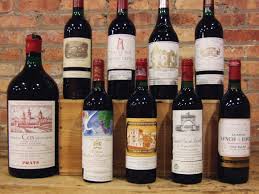
Some of the most prestigious wines in the world are blends. Bordeaux wines from the left bank of the Gironde River in France are typically blends of Cabernet Sauvignon with Merlot and Cabernet Franc. When blending Bordeaux varietals in the U.S. they are known as Meritage blends.The pronunciation is often subject of debate but the correct usage rhymes with heritage.
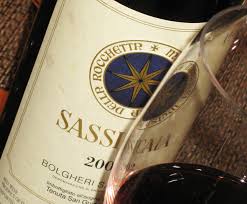
Sassicaia is approximately 15% Cabernet Franc blended with Cabernet Sauvignon to create one of the most sought after and priciest Super Tuscan wines made.
Robert Parker of Wine Advocate described Castello di Amorosa ‘s Super Tuscan blend, La Castellana as “Full-bodied, lush and seductive”. La Castellana marries Sangiovese and Merlot with Cabernet Sauvignon to create this blended masterpiece.
Blending grapes gives the advantage and potential of adding complexity to the resulting wine blend and provides a tapestry of multiple flavors and aromatics. It also offers an opportunity to achieve balance– the happy ‘marriage’ of fruit, acid, tannin, alcohol, and oak that makes great wines sing in perfect harmonic splendor and not-so-great wines seem full of wrong notes and missed opportunities.
People and grapes, we’re not so different.
Mama Mia!

Mary Davidek
Mama mia!
The great thing about a blog; I am able to write about whatever I am feeling or thinking or what may be inspiring me. Given the time of year and last week’s heat wave I considered an esoteric look at grilling and barbecue. But, in all honesty, the outdoor grill has never has been my forte. Cinco de Mayo had possibilities as cuisine from south of the border is infinitely more inspirational to me than a gas grill, a Weber or a hibachi–and practically anything made into a taco is delicious. However, as we approach Mother’s Day, I decided to take it home.
My Mom was a great cook which was no minor achievement for an Irish woman who married into an entirely Italian family. I’m not simply referring to pot roast or a weekday casserole. No, she was creative in her use of spices and seasoning. Mom was instinctively technically correct and taught me the importance of making food visually appealing before we had top celebrity chef royalty or cable networks devoted to food with culinary game shows and cooking competitions. As a child I would sit and play quietly each afternoon while my mom watched Julia Child or Graham Kerr aka The Galloping Gourmet. As they explained the dish featured on the episode she would comment “oooh, I think I will try that on Dad’s birthday” or “Julia is sure using a lot of cream today!”
My mom was also a great hostess and loved to entertain. Monthly cocktail parties were particularly exciting for me. Although I may not have sampled the libations, the yummy and abundant little treats made for the occasion were so tasty it was just cause for excitement– especially if mom’s delicious mini meatballs were on the menu! I knew while the adults milled about, that evening I would host a private party of one with my own little array of goods. With a Shirley Temple stuffed with more cherries than liquid in hand, off I would go to my bedroom for an evening of sitcoms du jour and yummy bits from the gala. Mom checked on me to replenish my sustenance but eventually I would nod off to the sound of canned laughter from the TV and the comforting banter of my parents and friends enjoying a festive evening in the background.
I guess I inherited mom’s love of entertaining and hopefully, her talent of being a great hostess as I have the distinct joy and pleasure of entertaining guests at the Castello on the ‘Royal Paring‘, a food and wine pairing experience. With one of the most beautiful settings in the world as my backdrop, and at times with a lump in my throat, I envision my mom smiling and nodding with approval at a job well done.
Happy Mother’s Day.
Salud.
Recipe: Italian Style Chicken Mini Meatballs
Pairing Wine with Vegetables | Castello di Amorosa

Mary Davidek
My Beef with Vegetables
When pairing wine and food, while vegetables are certainly a seasonal selection; wine and vegetables rarely makes a reasonable connection. When it comes to compatibility, wine and veggies make for a challenging relationship. However, with a little pairing intervention, we can salvage this savory dilemma.
First, let’s discuss the easy ones; mushrooms, potatoes and eggplant. Denser, heavier and earthier vegetables often used in heartier dishes. Think of the earthy quality of Pinot Noir to pair with these meaty veggies. A hearty mushroom like Portobello can even take on Bordeaux varietals like Merlot and Cabernet Sauvignon.
With green vegetables, play off the green flavors of these veggies by grilling and topping with a balsamic glaze. For richness add a cream sauce or cheese (there, I finally said it…you’ve been waiting for it!). These green flavors work well with Pinot Bianco or Pinot Grigio which often have notes of green fruit and provide a less aggressive palate then grassy and citrusy Sauvignon Blanc.
Asparagus and Artichokes. These delicious little buggers get their own space as they are notoriously difficult to pair with wine. This is due to cynarin. Cynarin is a phenolic acid compound found in the green leaves and seeds of artichokes and asparagus which gives a sweet flavor to these yummy vegetables. However, it can be challenging to complement these notes with wine because the sweetness is not from actual sugars and it makes most wines, even those with low levels of residual sugar, taste bitter. A sure way to contrast these flavors is with spicy aioli, a creamy dip, or a rich sauce. For wine, try an Austrian, Gruner Veltiner. Don’t underestimate this peppery white, Gruners are not to be taken lightly. This polished Austrian has attitude to spare and can finesse the most fickle flavors–even artichokes and asparagus.
If the addition of sauce, cheese, and cream is not an option as it can defeat the benevolent intentions of serving and eating vegetables, fear not, I have a sure fire way to make veggies almost wine-friendly; meat. Therein lies my beef with vegetables.
Merlot Beef with Broccoli
1 1/2 tablespoons cornstarch
1/4 teaspoon salt
1/4 teaspoon black pepper
3/4 pound sirloin beef tips, sliced against the grain 1/8 inch thick
3 tablespoons grapeseed oil
10 ounces broccoli florets
3 garlic cloves, chopped
3 tablespoons soy sauce
1/2 cup Merlot (approximately 4 ounces)
Toss together cornstarch, salt, pepper, and beef in a bowl until meat is coated. Heat 2 tablespoons oil in wok or sauté pan over medium high heat until hot but not smoking, stir-fry beef until just cooked through, approx. 1 minute. With a slotted spoon, transfer beef to another bowl and keep warm. Add remaining oil to sauté pan along with broccoli and garlic. Stir-fry until broccoli is just tender and garlic is pale golden, about 2 minutes. Add soy sauce and wine and bring to a low boil. Return meat to skillet. Stir until sauce is thickened.
I know; adding bacon is not playing fair but…absolutely delicious wine pairing with vegetables.
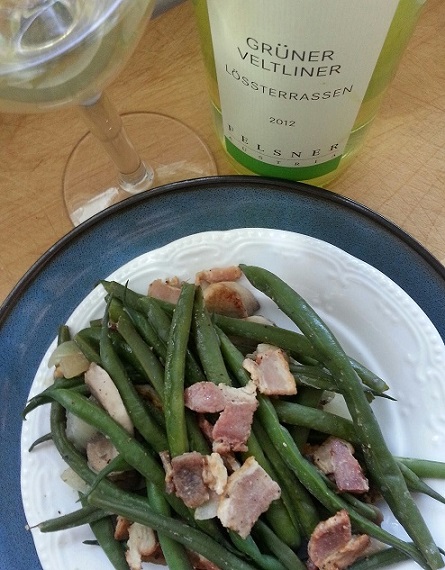
A little food and wine levity. When all else fails…..go back to the basics!
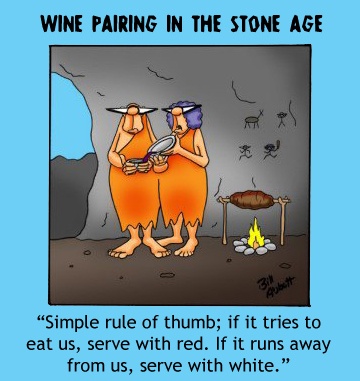
Cheese and Wine Whiz

Mary Davidek
A Royal Trio: Bread, Wine and Cheese
Cheese. It seems recently I’ve been spending a lot of time thinking about it, researching it, eating it, and writing about it. What makes this bacteria-induced, mold-laden, milk by-product so delicious in so many ways? From mac and cheese to grilled cheese sandwiches to omelets to enchiladas… is there anything good cheese doesn’t make better? Okay, I realize that is a rhetorical question which does not qualify an answer. Cheese-heads know of which I speak; plain, sliced, melted, and even burnt as one of my personal favorites is baked oozing cheese crusted on the edge of a big pan of lasagna.
In a word; cheese is yummy!
Cheese is not to be relegated to an also ran or a p.s. it is not Ed Mac Mahon to Johnny. No, the cheese can stand alone. Consider this, if you serve bread and a glass of wine with cheese, you now have a meal once reserved for royalty or highly ranked officials of medieval Western Europe. They favored hard, well-aged, and slightly salty cheeses, Parmigiano-Reggiano anyone?
Perhaps it is these century-old roots at the foundation of this tasty trio’s designation as the ‘trinity of the table’; bread, wine and cheese. In fact, this mouth-watering combo has something in common aside from being absolutely delicious. Bread, wine and cheese depend on yeast and bacteria for their development. Without the changes brought about by fermentation bread would not rise, wine would be lacking alcohol and we would exist in a world devoid of cheese. Fortunately we live in a world of a cheese-lover’s Shangri-La!
This homage to fromage is not intended to be a crash-course of pairing wine and cheese, but, simply an occasion to open the proverbial windows of our palate and imagine the possibilities…
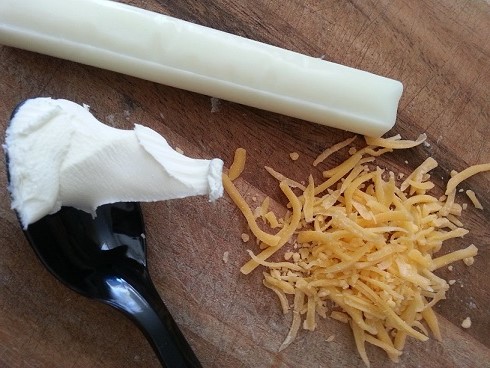
String, cream and grated–gateway cheeses which gave every American cheese-loving kid their humble beginning
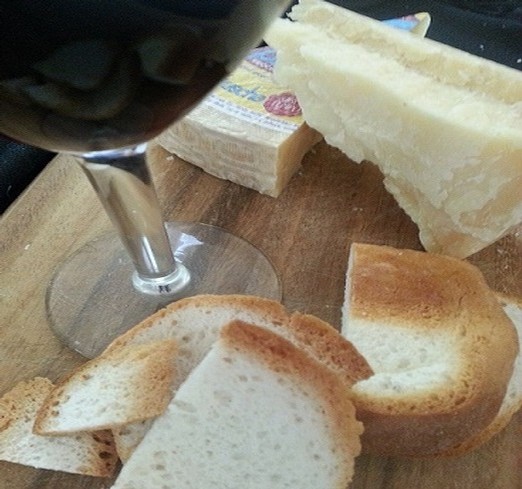
Eat like a king with this royal trio of bread, wine, and cheese. Bread? Nothing fancy, sometimes basic is all you need. Wine? Castello di Amorosa Il Brigante is just the right blend. Cheese? Piave Vecchio. Parmesan is well-suited for grating; Piave is slightly higher in milk fat which makes it a creamier option for a cheese board presentation.
Kick it up a notch. Add a reduction of balsamic to elevate this cheese pairing to a sweet and salty palate sensation.
The quintessential cheese plate typically offers a selection of 3 or more cheeses and makes use of color and texture. Combine a hard cheese and a double cream with a smoky cheddar. With the abundance of orange cheese, blue cheese and practically multicolored cheese; it is easy to add a splash of color.
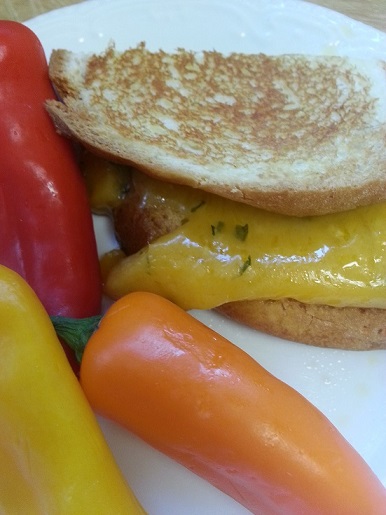
A conventional grilled cheese becomes an amazing culinary creation by using distinctive cheeses and experimenting with flavors. Pictured is Cotswold, a variation of Double Gloucester with the addition of chopped onions and chives. Cotswold is creamy, buttery, sweet and mild. Served with roasted sweet peppers- it is dangerously delicious.
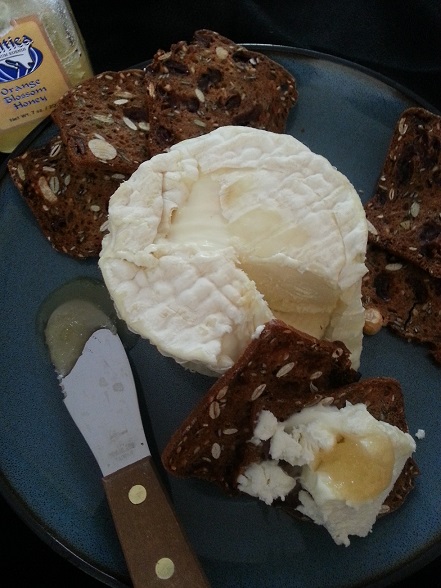
La Tur is an Italian triple cream from the Piedmont region of Italy and is made from an equal mixture of cow, sheep and goat milk. Typically with double and triple creams, I prefer a bright white wine like Pinot Bianco or a Dry Gewurztraminer. Here, I served La Tur with a dollop of orange blossom honey on a fig and oat cracker. Paired with Il Passito, the crown jewel of Castello di Amorosa– this was cheese and wine nirvana!
Roll into spring

Mary Davidek
Roll into spring
Ah, spring– Vernal Equinox! Vernal refers to spring and equinox is derived from Latin meaning “equal night” as days and nights are approximately equal everywhere. Increased daylight and the promise of warming temperatures brings the reawakening of flora and fauna. Spring refers not only to the time of year, but also to a season of rebirth, rejuvenation, renewal, resurrection, and regrowth; literally to ‘spring’ forth.
In Wine country, the dry winter grass has greened; the yellow –orange mustard is almost blindingly brilliant. Birds are chirping as they ready nests for soon to be hatched chicks. The low croak of frogs around the pond echoes and the rhythmic chirp of the night’s crickets are a sure sign of mild evenings.
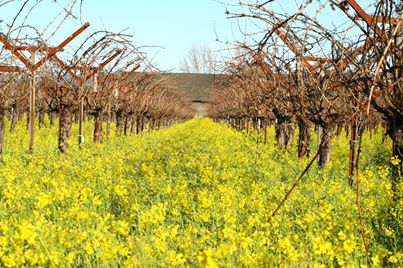
In the vineyard, young fragile buds break through as grapevines begin their annual growth cycle.
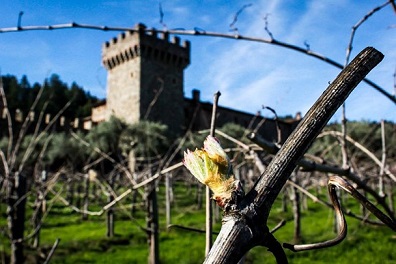
The extra winter blanket is folded and tucked away and the windows are now opened to welcome a fresh breeze each morning. A big glass of iced tea in the afternoon is suddenly more appealing than a hot mug of Earl Grey and a day at the coast requires umbrellas intended for shade instead of showers.
Spring also holds the possibility of picnics, baseball games, back yard barbecues and dining al fresco. Days off spent indoors seems sacrilegious when the warm sun demands our presence. For dinner; thoughts of salads and grilled kebabs are edging out from the shadow of winter’s hearty soups and casseroles and a perfectly chilled white wine seems like a great way to end a day as we linger a little longer each night before twilight.
As you ease into Spring, relax a bit later each day, stop and smell the green—and if there is snow on the ground outside your door, hang on! You’ll be rolling into spring before you know it.
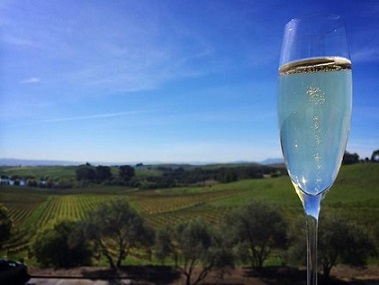
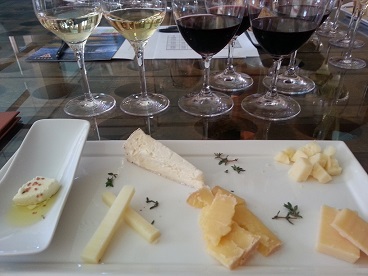
A beautiful Spring day in the Carneros region of Napa Valley!
First, a stop by Domaine Carneros for sparkling and then a cheese pairing at Artesa Winery. This is what I call a ’market research’ day!
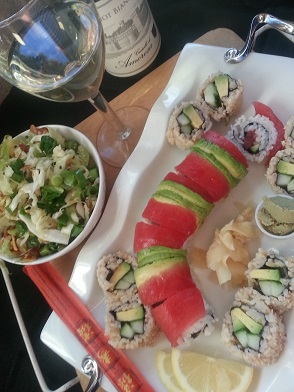
After a long day of tough research (ahem), dinner has to be quick and easy. This Asian cabbage slaw is flavorful, easy to make, and packed with healthy veggies. The 2012 Castello di Amorosa Pinot Bianco is an elegant juicy fruit- laden white; light, zippy and refreshing. Perfect with this Rainbow Sushi Roll and exotic Asian flavors.
Asian Cabbage Slaw
Ingredients:
¼ cup soy sauce
¼ cup mirin (or white wine vinegar)
2 tablespoons water
1 teaspoon sesame oil
1 Pinch of red pepper flakes
1 tablespoon brown sugar
1 tablespoon grape seed oil
½ large white cabbage, shredded
1 cup thinly sliced scallions
¼ cup toasted almond slivers or cashew pieces
2 ounces broken ramen noodles
1 tablespoon toasted sesame seeds
Mix soy sauce, mirin, water, sesame oil, red pepper flakes and brown sugar in a small pot over low heat. Heat, stirring, just until the sugar has fully dissolved. Whisk in the grape seed oil and set aside to cool.
Place the cabbage, scallions, almond slivers, and uncooked noodles in a salad bowl. Pour half of the dressing over and toss until every piece of vegetable is coated. Add more dressing until the salad is well coated. The remaining dressing will keep in a sealed container in the fridge for at least 1 week.
Garnish with sesame seeds or mandarin orange slices.
Artistic Super Tuscans

Mary Davidek
Artistic Super Tuscans
You may suspect a read detailing the work of Leonardo da Vinci, Michelangelo or Botticelli as Tuscany is known for its artistic contributions. Florence, the heart of Tuscany, is considered to be the birthplace of the Renaissance and is one of the most important cities in the world for art lovers and historians. Tuscany boasts some of the world’s most prized works of art in the numerous museums and art galleries, the Uffizzi, the Pitti Palace, and the Bargello, just to name a few.
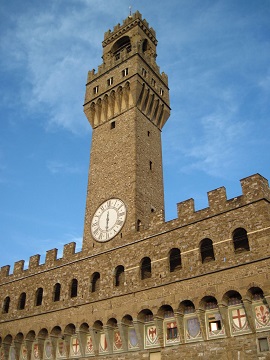
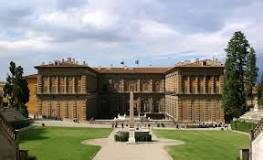
The Uffizzi Gallery (left) and the Palazzo Pitti (right) are home to some of Tuscany’s most valuable works of art.
Aside from its artistic legacy, the cultivation and appreciation of wine is also deeply steeped in the history of Tuscany. Italy is one of the oldest wine-producing regions of the world and is still the largest wine producer by volume. There are over 350 different wine grapes commonly cultivated in Italy and many of these are indigenous to Tuscany. In Tuscany you can find everything from unpretentious local village wines to more sought after and prestigious wines like Brunello de Montalcino, Chianti Classico or Super Tuscans.
The ‘super’ heroes of Italian wine
In the early 1980’s prominent Tuscan wine producers believed the legal rules of the DoC and DoCG (Italian wine law) governing the production of Chianti were too restrictive. For example, they required the use of some white grapes and they prohibited blending non-indigenous grapes i.e. Cabernet Sauvignon, Merlot or Syrah. In an effort to produce the best wines and embrace artistry in their craft they continued to use these less traditional grape varietals. Although not legally defined or regulated, the term “Super Tuscan” was coined to distinguish these artistically expressive wines from the inexpensive, lower quality wines that were typically associated with the term vino da tavola, or ‘table wine’.
Today, super Tuscans use the legal labeling of IGT (Indicazione Geografica Tipica), which gives producers more flexibility, or artistic license, and certainly has more cachet than vino da tavola. Super Tuscans now represent some of the most luxurious wines of Italy and tend to be modern, big and rich—and often carry a price tag exceeding $100- $200 a bottle.
Some super Tuscans contain Sangiovese but others are made solely from Merlot (like the famous Tenuta dell’Ornellaia Toscana Masseto), or from a blend of Cabernet Sauvignon and Syrah (Riccardo Baracchi Toscana Ardito), or from even less traditional varietals, like a combination of Petit Verdot, Cabernet Sauvignon, Syrah and Merlot (Argiano Toscana Solengo).
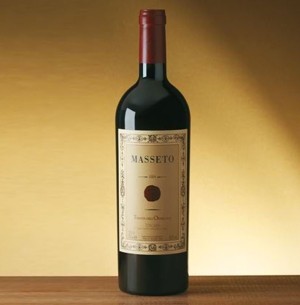
Castello di Amorosa’s 2009 La Castellana is 70% Cabernet, 15% Sangiovese and 15% Merlot. Exotic dried plum and tinder box on the nose and a refined palate of brooding dark cherry and dusty cocoa.
Our 2010 vintage, the first blended by Sebastiano Rosa of Italy’s famed Sassicaia has garnered a whopping 92 points from James Laube of Wine Spectator.
Sebastiano may be Castello di Amorosa’s Super-hero Tuscan!
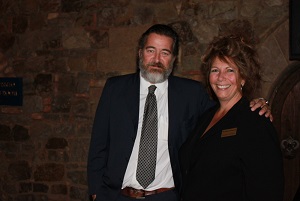
Score!

Mary Davidek
Score! – Wine Rating Scale Explained
American Idol, Miss USA, The Olympics, elections, books, dancing, movies, food, wine. From singing competitions to the food we eat and the wine we drink, it is compared and calibrated by a score. What are the parameters used to grant a number or a rating and how reliable are ratings when so much of what we find pleasing, appealing or excellent is purely subjective. For instance, can we look to a score on a bottle of Cabernet Sauvignon to gauge a wine’s potential for enjoyment when individual tastes vary so widely? Wine is scrutinized, gauged and rated not by peers or consumers but, by ‘professionals’ who ascribe these ratings as a score intended for submission to the public via magazines, websites, social media etc.
Let’s dissect and analyze what a wine score is. What goes into a wine rating?
A wine rating is a score assigned by one or more wine critics for a wine tasted as a summary of that critic’s evaluation of that wine. A wine rating is therefore a subjective quality score, typically numerical. Over the last couple of decades, the 50-100 scale introduced by Robert M Parker Jr. has become the standard. This wine rating scale is now used by ‘the big 3’, Wine Enthusiast, Wine Spectator, and Wine Advocate.
95-100 Classic: a great wine
90-94 Outstanding: a wine of superior character and style
85-89 Very good: a wine with special qualities
80-84 Good: a solid, well-made wine
75-79 Mediocre: a drinkable wine that may have minor flaws
50-74 Not recommended
In addition to a simple numerical score most wine ratings are meant to be a supplement to the wine tasting notes, which are brief descriptions of the critic’s impression of the wine, including aromatics, flavor qualities, and ageing potential or drinking window. However, the emphasis is more often on the score applied by a critic rather than on the actual tasting notes.
Castello di Amorosa wines have been well received by ‘The Big 3’. Parker’s accolades for Il Barone and La Castellana were a huge boon for Castello di Amorosa as one of our first published big ratings. Wine Enthusiast’s critical acclaim for Castello’s wines is a source of great pride and most recently, Wine Spectator has granted some very big numbers indeed.
2010 La Castellana: James Laube, Wine Spectator (92 Points) – Intense, with firm, ripe, vibrant cedar, red and dark berry, anise and loamy earth flavors, framed by chewy tannins and ending with a long finish laced with notes of black licorice. Drink now through 2024.
2010 Don Thomas: James Laube, Wine Spectator (94 Points) – Amazingly complex and refined, tuned to a mix of red and dark berry that’s elegant and graceful without sacrificing Cabernet’s power and torque. Ends with classic Bourdeaux-like cedar and cigar box touches, gliding along with fine-grained tannins. Drink now through 2028.
In an effort to remain unbiased, educated and in-touch with the amazing wines of Napa Valley we conduct blind tastings throughout the year for our Castello staff to participate in.
A great tasting needs a great room!
We tasted 27 different Napa Valley Cabernet Sauvignon in the Great Hall of Castello di Amorosa–
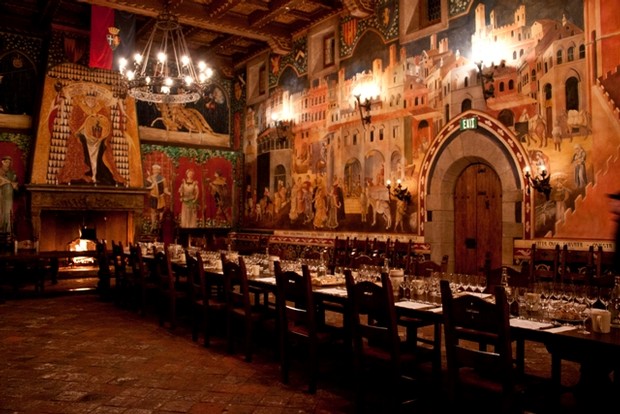
Here is the line-up….

The bottles were placed in a brown bag and numbered by a non-tasting non-voting participant….
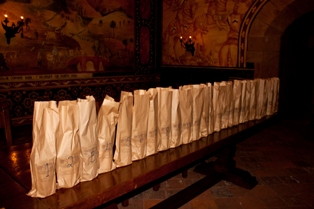
….which guarantees an unbiased result.
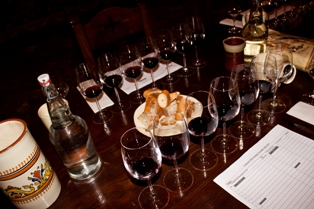
Castello Pres Georg Salzner and Vice President Jim Sullivan enter the results.
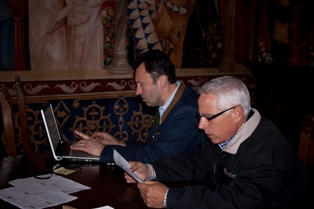
The room cheered when the winner was revealed!
Check out more great scores for Castello di Amorosa’s wines-
Castello di Amorosa Wine Accolades
A sweet finale on the Castello di Amorosa Royal Pairing, the Fantatini. Recipe?… Simple. Scoop and pour!
Opening Ceremonies and Gold Medals

Mary Davidek
Opening Ceremonies and Gold Medals
As the western United States wades through another year of drought and record- breaking almost non-existent rainfall totals (so far!), old man winter has tackled the mid-west and sucker-punched much of the nation with record-breaking cold temps. Another event is approaching to further benchmark winter 2014. On February 06 the 22nd Winter Olympic Games begin in Sochi Russia—and the opening ceremonies televised on February 07 are sure-to-be epic.
The first celebration of the Winter Olympic Games was held in Chamonix, France in 1924 and have now been hosted on three continents. Twelve countries have attended every Winter Olympic games and six of those (Austria, Canada, Finland, Norway, Sweden and the United States) have earned medals at every Winter Olympic Games. However, only one – the United States – has earned gold at each Olympic Games.
In wine country, January ushers in one more iconic winter event, The San Francisco Chronicle Wine Competition. This competition began in 1983 as the Cloverdale Citrus Fair Wine Competition. Today, it is known as the San Francisco Chronicle Wine Competition and holds the title of the largest competition of American Wines in the World….a wine Olympics. On the subject of olympics and medals and earning gold (in wine competitions there is a double gold and the coveted Best of Class!), I could turn this into an all-around high-five big kudos to Castello di Amorosa’s amazing wine making team with the recent Gold Medal performances but instead, I am getting ready for a sure-to-be-epic opening ceremony of my own, time for a glass of gold medal winning Cabernet Sauvignon.
Beyond Double Gold—Best of Class
♦ 2012 Pinot Bianco
♦ 2012 Dry Gewürztraminer
♦ 2009 Napa Valley Cabernet Sauvignon
Best of Class and tonight, best in the glass
2009 Castello di Amorosa Cabernet Sauvignon is one of my favorite Cabernets. It exhibits depth and strength but exudes finesse and elegance. Exactly what every gold medalist needs—power and grace!
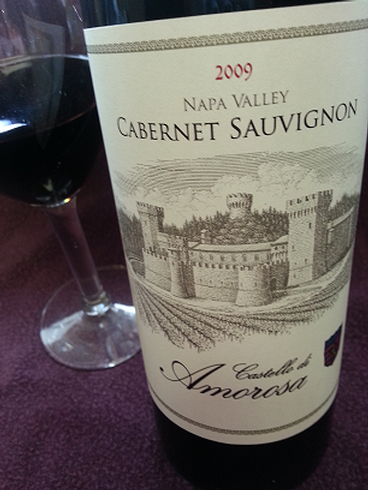
Opening Ceremony Night Dinner –Because timing is important too!
Salisbury Steak with Fingerling Potato Hash
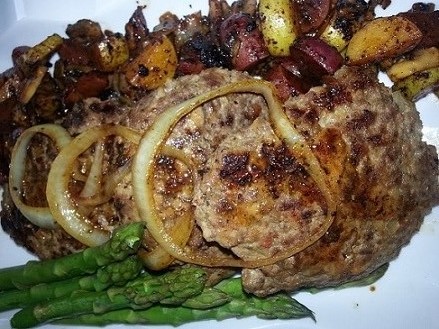
Make this revised classic in 30 minutes!
For the Salisbury Steaks combine:
- 1.5 pound lean ground beef
- 1 tsp. coarse ground pepper
- ½ sweet onion finely chopped
- ½ package onion soup mix
- 1 tsp. mustard
- 1 tsp. ketchup
- 1 egg
- 2 tsps. Worcestershire
Form into 4-6 oval patties and brown in large sauté pan, approximately 2-3 minutes each side. Remove and place in shallow backing dish and finish in 350 degree oven for 10-15 minutes.
Potato Hash:
Dice potatoes, mushrooms, and remaining ½ sweet onion. Brown onion in 3 Tbsp. butter. Add mushrooms and potatoes after onions have begun to sweat. Add beef stock/broth, salt and pepper to taste. Bring to a slow simmer adding broth as needed approx.15 minutes.
Remove Salisbury Steaks from oven and serve with hash
Enjoy!
Experience Taste

Mary Davidek
Experience Taste
While enjoying a ‘Royal Pairing’ at the Castello, it happened. Once again, the stage was perfectly set. The winter wind was blowing and the unending sunshine had temporarily given way to much-needed rainfall. Through looming clouds the late afternoon sun peeked out just enough to splash a bright ray of light dazzling the Vaca Mountains. During this tasting experience….it happened…we fully experienced the tasting and the afternoon was thoroughly enjoyed by all.
Is a wine tasting experience simply a contemplation of taste? To savor or enjoy on our palate? Or, is how we taste influenced by all of our senses and emotions subject to and affected by our surroundings? Wine tasting is defined as the “palate’s examination and evaluation of taste”. I can’t find fault with this scientific and clinical definition, but, it does seem sterile. When tasting wine our sensations of taste and smell are fundamental, however, by setting the stage we can taste not just what is in the glass, but, we can savor the entire experience; experience taste.
A wine tasting experience is visual- demonstrated by Castello president Georg Salzner and Dario Sattui

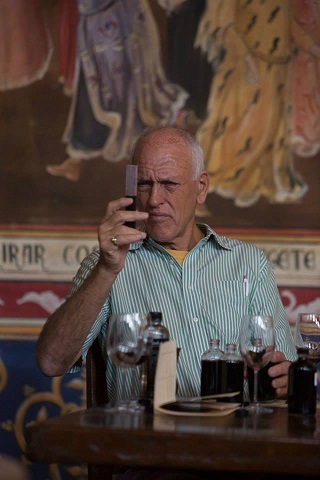
Not only by examining the content of the glass….
a beautiful environment impacts our enjoyment of an experience.
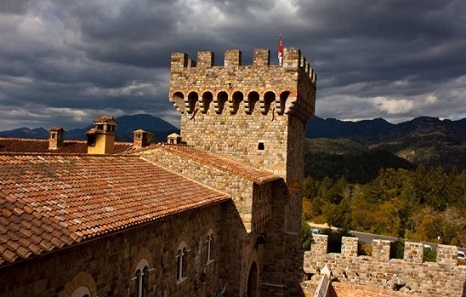

The room was picture-perfect, warm and inviting. The glasses were glistening and the candles were glowing.
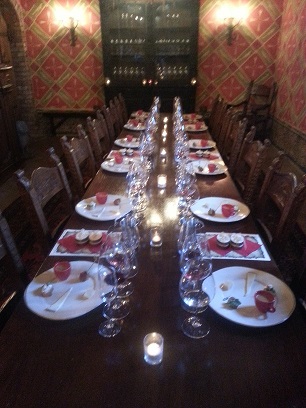
Many chefs are fond of the saying, “we eat with our eyes first”, and there is research to support this. Studies have shown when we find food visually appealing, not only do we enjoy it more, we also absorb more nutrients from it.
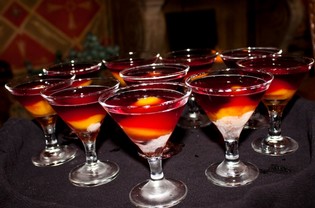
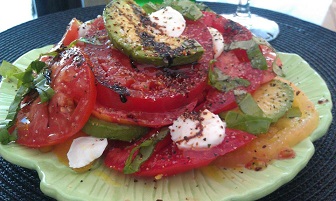
What we hear also has impact. Music evokes emotions and feelings and can be far more powerful than spoken language. Andrea Bocelli gets me every time…

The most important element is to surround yourself with friends and people you love. Create a tasting experience whenever you want and wherever you are and you will truly experience taste.
Castello team members Alison, Jason, Kylee and Melissa sharing laughs and great vino!
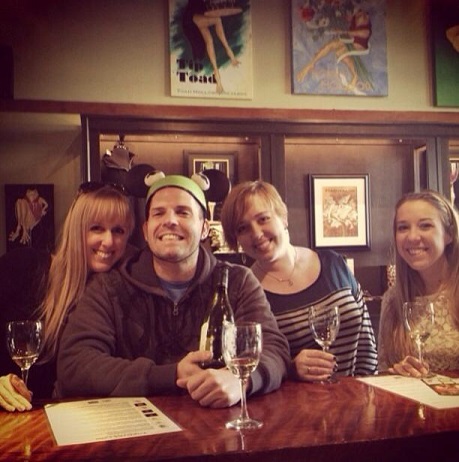
My husband and I sharing a moment….salud!
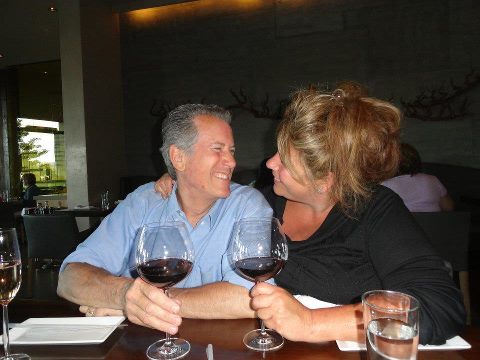
My 2014 Food and Wine Resolutions

Mary Davidek
My 2014 Food and Wine Resolutions
According to research conducted by the University Of Scranton Journal Of Clinical Psychology, although the majority of Americans make annual proclamations and set yearly goals with good intentions, less than 8% of us actually achieve success in keeping New Year’s resolutions. Here is a list of the top 10 yearly resolutions:
- Lose weight
- Get organized
- Save money
- Enjoy life to the fullest
- Get fit and healthy
- Learn something exciting
- Quit smoking
- Help others with their dreams
- Fall in love
- Spend more time with family
The sure way to improve on this dismal statistic? Set obtainable goals. Unrealistic resolutions are destined for failure so I’ve created a list of 10 highly achievable food and wine resolutions to put myself on task over the next 12 months. Even if I don’t strike the entire 10, I am bound to have a great time trying! In 2014 I resolve to…
♦ Make a cheese soufflé
A masterpiece of a thickened white sauce paired with flavorful cheese. The inside is delicate and warm and the bottom and sides are crusted together forming a heavenly thick cheese layer. Nirvana! 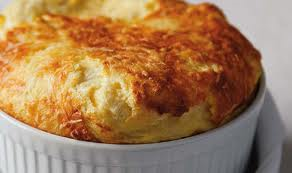
♦ Eat more fish
Seafood is healthy, light and the perfect canvas for many amazing spices and preparations. My good friends Tim and Carol Berg at www.great-alaska-seafood.com have spoiled me rotten with the freshest seafood available and this feast was no exception. Scallops with Pappardelle pasta in a Tarragon cream sauce. Decadent!
. 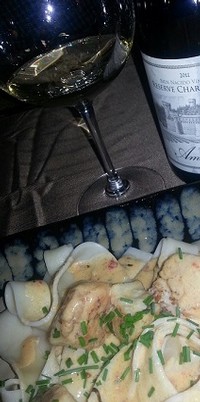
♦ Pair more sweet wine with savory foods
On the Royal Pairing tour at the Castello, sweet and savory is a palate pleaser and always promises alluring and exotic pairing possibilities. Castello di Amorosa Dolcino Gewurztraminer and Moroccan spiced pork loin looming on the horizon.
♦ Try one new restaurant a month
Even here in the promised land of epicurean delights –I get in a rut. The same four restaurants seem to be on my go-to list not because I don’t have seemingly infinite choices but because…well… the choices can seem infinite! January is a great time to start as it is Napa Valley Restaurant Month and a perfect opportunity for new restaurant adventures.
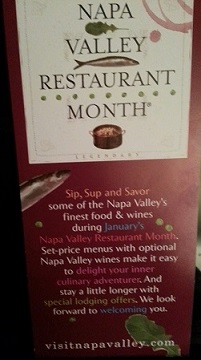
♦ Visit one new winery a month
With 450+ wineries just in Napa Valley and 1600+ in a 150 mile radius! How many days in a year?
♦ Eat vegetarian for 30 days
I love vegetables of all kinds and welcome this 30 day meat free stint.
♦ Take a class
I aspire to become more educated on the vine to wine process— after nearly 20 years on this side of the glass, I am still amazed at the sheer scientific/artistic process in which we finally arrive at this crazy delicious fermented grape juice. As much as I read and learn I realize how much there is yet to discover. Hence, the love of this elixir!
♦ Buy more magnums
Magnums, or 1.5 L is equal to 2 standard 750 ml bottles. Magnums not only have a ‘wow’ factor but wines from a mag show better with more fruit and an intangible zip. When one bottle isn’t quite enough, one bottle of 1.5L often is just enough.
♦ Take more culinary risks
I am reluctant to try new techniques (see resolution #1) as I fear failure. The catastrophic kind of kitchen failure. I have heard from some professional chefs that the reason there are more males than females in the culinary industry is because men are not afraid to make mistakes. If something isn’t right, most men will simply toss it and have another go at it. Women become attached; we want to ‘save’ it and ‘fix’ it. By the way, I am referring to culinary attempts here but it seems this theory has many applications. =)
♦ Travel!
I want to spend an entire month in Italy. Not a rushed jaunt or a hurried two week trek! I want to go for a month with time to explore and savor—maybe take an Italian cooking class in Tuscany. I want to drink local wine, aimlessly roam the streets, drink in the art and feast on authentic cuisine. For a month I will absorb everything Castello di Amorosa summons in my heart and in my mind. Hear that Castello? Consider this my official vacation request; January 2015 will be blogged from fair Firenze!
Ciao!
